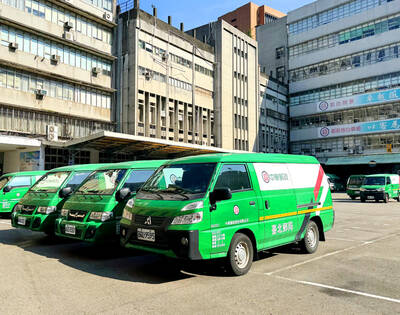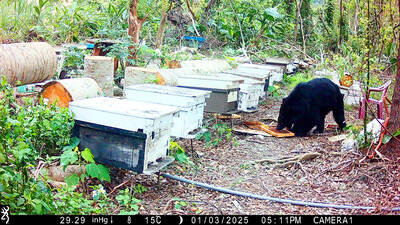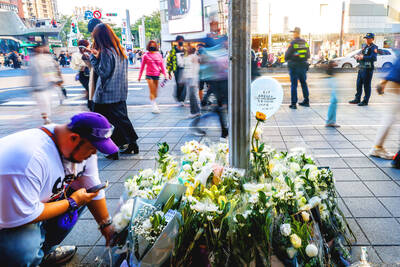Fermented bean curd products illegally imported from China pose a safety risk and people should not eat them, Deputy Minister of Health and Welfare Lin Ching-yi (林靜儀) said on Tuesday.
Lin’s warning followed reports from local media, including the Chinese-language Liberty Times (the Taipei Times’ sister newspaper), that posts about Chinese food called “moldy bean curd” (霉豆腐) had gone viral on Facebook in Taiwan.
However, the food product — which is mostly homemade or smuggled in from China — might pose a safety risk due to the lack of official verification of the sources of its ingredients and safety tests, the reports said.

Photo: CNA
The fermented bean curd being sold online in Taiwan is a “three noes” item, meaning that the products carry no maker’s name, no authorization mark and no approval label, Lin told reporters.
The products were clearly sold or brought into Taiwan illegally, given the lack of Ministry of Health and Welfare certification, she said.
People should not purchase “moldy bean curd” online, as the manufacturing process, including the selection and storage of soybeans and production management, is unknown, she said.
Such canned food products, if not properly sanitized, can contain potentially lethal amounts of Clostridium botulinum bacteria, she said.
People might “find it difficult to seek redress” if they become ill after consuming such food, she added.
Selling such products is against the law and people who contravene the law could face criminal penalties, Lin said.
The ministry and local governments are working together to increase inspections and seizure of such items, she said.
Yen Tzung-hai (顏宗海), director of the Clinical Poison Center at Linkou Chang Gung Memorial Hospital, said fermented bean curds are high in sodium and have a “heavy” taste.
Consuming too much can cause hypertension and cardiovascular diseases, Yen said.

SHIPS, TRAINS AND AUTOMOBILES: The ministry has announced changes to varied transportation industries taking effect soon, with a number of effects for passengers Beginning next month, the post office is canceling signature upon delivery and written inquiry services for international registered small packets in accordance with the new policy of the Universal Postal Union, the Ministry of Transportation and Communications said yesterday. The new policy does not apply to packets that are to be delivered to China, the ministry said. Senders of international registered small packets would receive a NT$10 rebate on postage if the packets are sent from Jan. 1 to March 31, it added. The ministry said that three other policies are also scheduled to take effect next month. International cruise ship operators

NUMBERS IMBALANCE: More than 4 million Taiwanese have visited China this year, while only about half a million Chinese have visited here Beijing has yet to respond to Taiwan’s requests for negotiation over matters related to the recovery of cross-strait tourism, the Tourism Administration said yesterday. Taiwan’s tourism authority issued the statement after Chinese-language daily the China Times reported yesterday that the government’s policy of banning group tours to China does not stop Taiwanese from visiting the country. As of October, more than 4.2 million had traveled to China this year, exceeding last year. Beijing estimated the number of Taiwanese tourists in China could reach 4.5 million this year. By contrast, only 500,000 Chinese tourists are expected in Taiwan, the report said. The report

The Forestry and Nature Conservation Agency yesterday launched a gift box to market honey “certified by a Formosan black bear” in appreciation of a beekeeper’s amicable interaction with a honey-thieving bear. Beekeeper Chih Ming-chen (池明鎮) in January inspected his bee farm in Hualien County’s Jhuosi Township (卓溪) and found that more than 20 beehives had been destroyed and many hives were eaten, with bear droppings and paw prints near the destroyed hives, the agency said. Chih returned to the farm to move the remaining beehives away that evening when he encountered a Formosan black bear only 20m away, the agency said. The bear

HORROR STORIES: One victim recounted not realizing they had been stabbed and seeing people bleeding, while another recalled breaking down in tears after fleeing A man on Friday died after he tried to fight the knife-wielding suspect who went on a stabbing spree near two of Taipei’s busiest metro stations, Taipei Mayor Chiang Wan-an (蔣萬安) said. The 57-year-old man, identified by his family name, Yu (余), encountered the suspect at Exit M7 of Taipei Main Station and immediately tried to stop him, but was fatally wounded and later died, Chiang said, calling the incident “heartbreaking.” Yu’s family would receive at least NT$5 million (US$158,584) in compensation through the Taipei Rapid Transit Corp’s (TRTC) insurance coverage, he said after convening an emergency security response meeting yesterday morning. National